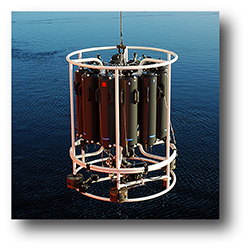 Pacific-Arctic Carbon Synthesis – Transformations, Fluxes, and Budgets
Pacific-Arctic Carbon Synthesis – Transformations, Fluxes, and Budgets
Funding Agency: NSF Office of Polar Programs, Arctic System Science Program
Collaborators: J. Mathis (University of Alaska, Fairbanks), N. Bates (Bermuda Institute of Ocean Sciences), and L. Juranek (University of Washington).
Funding Period: 2011-2015
Predicting future conditions of the Arctic Ocean system requires scientific knowledge of its present status as well as a process-based understanding of the mechanisms of change. This research effort will synthesize a number of recent, upcoming, and historical datasets to create three regional carbon budgets for the Chukchi/western Beaufort Sea, the Bering Sea, and the northern Gulf of Alaska. As waters from the North Pacific make their way through these regions a number of transformations occur that modify them before they enter the central Arctic Ocean. In general, the waters exiting these shelf seas are fresher, colder, and have lower pH due to the uptake of CO2 and the remineralization of organic matter. Because of the importance that biogeochemical transformations have in preconditioning the waters of the central Arctic and ultimately parts of the North Atlantic it is important to gain a better understanding of how these processes impact the carbon biogeochemistry of the region. The investigators proposed to address this issue by better constraining the carbon budgets for three zones in the Pacific sector of the Arctic Ocean including coastal fluxes, rates of primary production and air-sea exchange of CO2 as well as developing algorithms with predictive capabilities for carbonate mineral saturation states. The aim of this effort was to determine how physical forcing and biological responses control the marine carbon cycle including the rates of air-sea CO2 exchange and net community production as well as ocean acidification effects in the contrasting shelf environments, and to better constrain the present stocks and fluxes of carbon and determine how climate change will affect the regional carbon cycle. The project supported four early career investigators, a postdoctoral scientist, and a Ph.D. student.
Resulting Publications:
Evans, W., J. T. Mathis, J. N. Cross, N. R. Bates, K. E. Frey, B. G. T. Else, T. N. Papkyriakou, M. D. DeGrandpre, F. Islam, W. -J. Cai, B. Chen, M. Yamamoto-Kawai, L. A. Miller, E. Carmack, W. J. Williams, and T. Takahashi (2015), Sea-air CO2 exchange in the western Arctic coastal ocean. Global Biogeochemical Cycles 29, doi:10.1002/2015GB005153 (20 pp.). pdf copy
Frey, K. E., J. A. Maslanik, J. Clement Kinney & W. Maslowski (2014), Recent variability in sea ice cover, age, and thickness in the Pacific Arctic Region. In: Grebmeier, J. M. & W. Maslowski (eds.) The Pacific Arctic Region: ecosystem status and trends in a rapidly changing environment. Springer: Dordrecht, pp. 31–64. pdf copy
Bates, N. R., R. Garley, K. E. Frey, K. L. Shake & J. T. Mathis (2014), Sea-ice melt CO2-carbonate chemistry in the western Arctic Ocean: meltwater contributions to air-sea CO2 gas exchange, mixed-layer properties and rates of net community production under sea ice. Biogeosciences 11, 6769–6789, doi:10.5194/bg-11-6769-2014. pdf copy
Cross, J. N., J. T. Mathis, K. E. Frey, C. Cosca, S. L. Danielson, N. R. Bates, T. Takahashi & W. Evans (2014), Annual sea-air CO2 fluxes in the Bering Sea: Insights from new autumn and winter observations of a seasonally ice-covered continental shelf. Journal of Geophysical Research-Oceans 119, doi:10.1002/2013JC009579 (16 pp.). pdf copy
Bhatt, U. S., D. A. Walker, J. E. Walsh, E. C. Carmack, K. E. Frey, W. N. Meier, S. E. Moore, F. W. Parmentier, E. Post, V. E. Romanovsky, W. R. Simpson (2014), Implications of Arctic Sea Ice Decline for the Earth System. Annual Reviews of Environment and Resources 39, doi:10.1146/annurev-environ-122012-094357 (33 pp.). pdf copy
